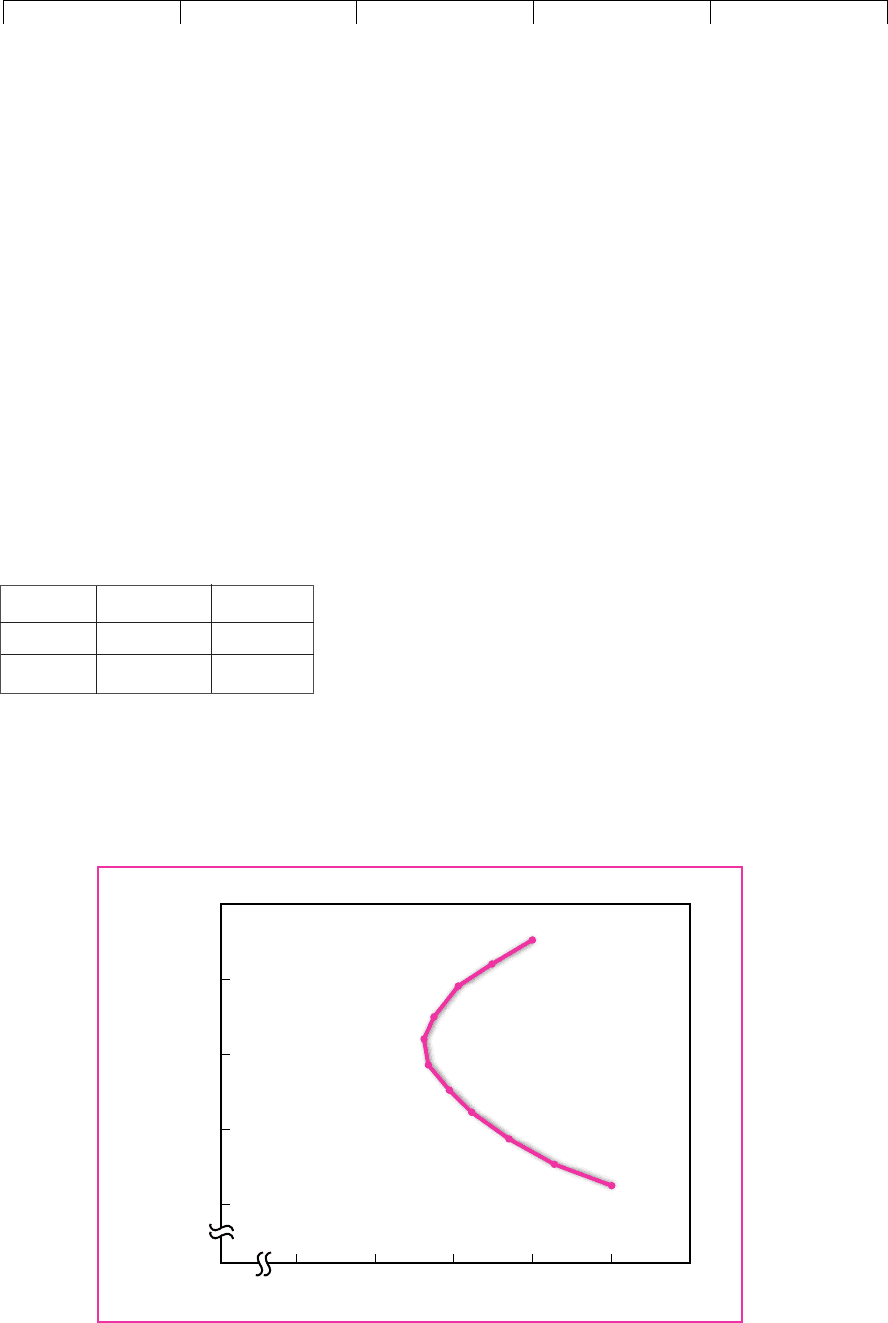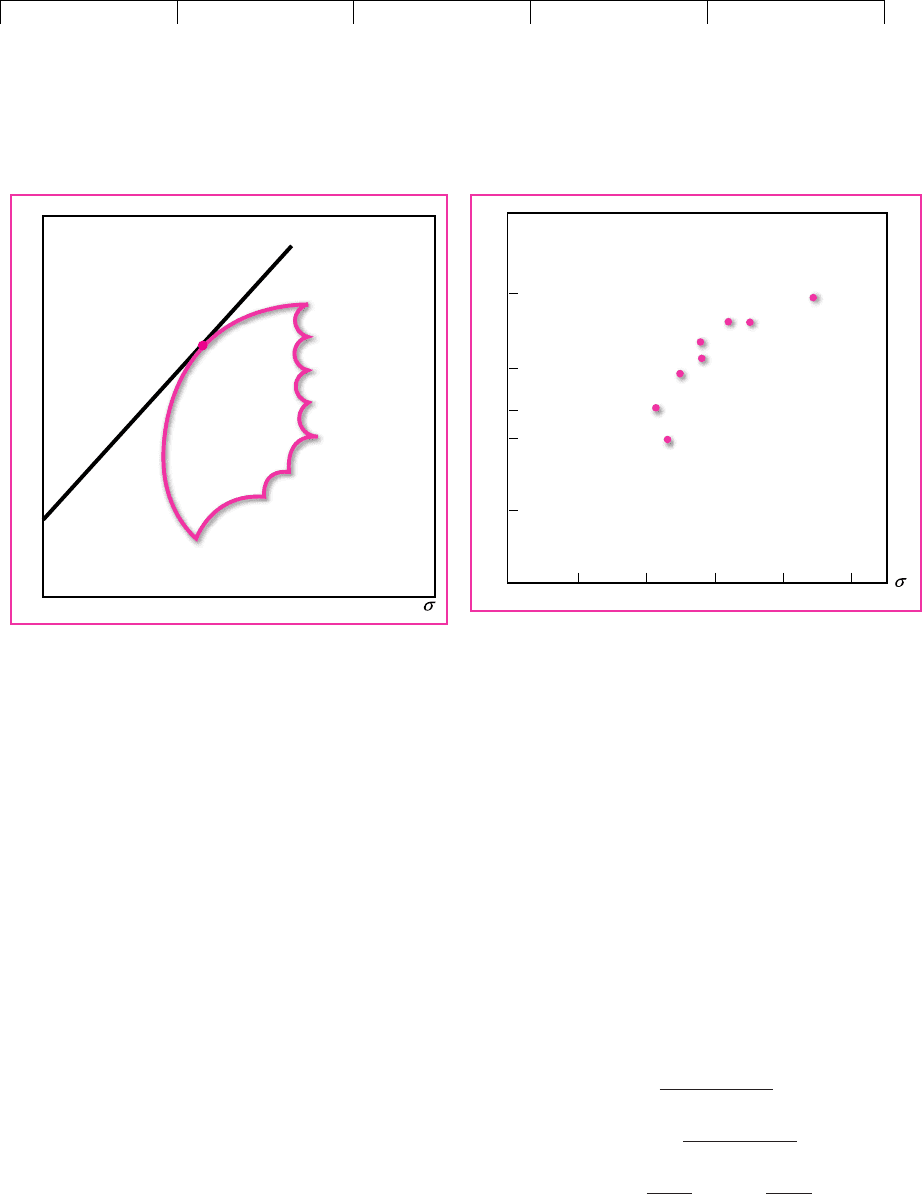Brealey, Myers. Principles of Corporate Finance. 7th edition
Подождите немного. Документ загружается.


Brealey−Meyers:
Principles of Corporate
Finance, Seventh Edition
Back Matter Appendix A Present Value
Tables
© The McGraw−Hill
Companies, 2003
Appendix A Present Value Tables 1013
rt .00 .01 .02 .03 .04 .05 .06 .07 .08 .09
2.00 7.389 7.463 7.538 7.614 7.691 7.768 7.846 7.925 8.004 8.085
2.10 8.166 8.248 8.331 8.415 8.499 8.585 8.671 8.758 8.846 8.935
2.20 9.025 9.116 9.207 9.300 9.393 9.488 9.583 9.679 9.777 9.875
2.30 9.974 10.07 10.18 10.28 10.38 10.49 10.59 10.70 10.80 10.91
2.40 11.02 11.13 11.25 11.36 11.47 11.59 11.70 11.82 11.94 12.06
2.50 12.18 12.30 12.43 12.55 12.68 12.81 12.94 13.07 13.20 13.33
2.60 13.46 13.60 13.74 13.87 14.01 14.15 14.30 14.44 14.59 14.73
2.70 14.88 15.03 15.18 15.33 15.49 15.64 15.80 15.96 16.12 16.28
2.80 16.44 16.61 16.78 16.95 17.12 17.29 17.46 17.64 17.81 17.99
2.90 18.17 18.36 18.54 18.73 18.92 19.11 19.30 19.49 19.69 19.89
3.00 20.09 20.29 20.49 20.70 20.91 21.12 21.33 21.54 21.76 21.98
3.10 22.20 22.42 22.65 22.87 23.10 23.34 23.57 23.81 24.05 24.29
3.20 24.53 24.78 25.03 25.28 25.53 25.79 26.05 26.31 26.58 26.84
3.30 27.11 27.39 27.66 27.94 28.22 28.50 28.79 29.08 29.37 29.67
3.40 29.96 30.27 30.57 30.88 31.19 31.50 31.82 32.14 32.46 32.79
3.50 33.12 33.45 33.78 34.12 34.47 34.81 35.16 35.52 35.87 36.23
3.60 36.60 36.97 37.34 37.71 38.09 38.47 38.86 39.25 39.65 40.04
3.70 40.45 40.85 41.26 41.68 42.10 42.52 42.95 43.38 43.82 44.26
3.80 44.70 45.15 45.60 46.06 46.53 46.99 47.47 47.94 48.42 48.91
3.90 49.40 49.90 50.40 50.91 51.42 51.94 52.46 52.98 53.52 54.05

Brealey−Meyers:
Principles of Corporate
Finance, Seventh Edition
Back Matter Appendix A Present Value
Tables
© The McGraw−Hill
Companies, 2003
1014 Appendix A Present Value Tables
APPENDIX TABLE 5
Present value of $1 per year received in a continuous stream for each of t years (discounted at an annually compounded
rate r) ⫽ {1 ⫺ 1/(1 ⫹ r)
t
}/{ln(1 ⫹ r)}.
Number
Interest Rate per Year
of Years 1% 2% 3% 4% 5% 6% 7% 8% 9% 10% 11% 12% 13% 14% 15%
1 .995 .990 .985 .981 .976 .971 .967 .962 .958 .954 .950 .945 .941 .937 .933
2 1.980 1.961 1.942 1.924 1.906 1.888 1.871 1.854 1.837 1.821 1.805 1.790 1.774 1.759 1.745
3 2.956 2.913 2.871 2.830 2.791 2.752 2.715 2.679 2.644 2.609 2.576 2.543 2.512 2.481 2.450
4 3.922 3.846 3.773 3.702 3.634 3.568 3.504 3.443 3.383 3.326 3.270 3.216 3.164 3.113 3.064
5 4.878 4.760 4.648 4.540 4.437 4.337 4.242 4.150 4.062 3.977 3.896 3.817 3.741 3.668 3.598
6 5.825 5.657 5.498 5.346 5.202 5.063 4.931 4.805 4.685 4.570 4.459 4.353 4.252 4.155 4.062
7 6.762 6.536 6.323 6.121 5.930 5.748 5.576 5.412 5.256 5.108 4.967 4.832 4.704 4.582 4.465
8 7.690 7.398 7.124 6.867 6.623 6.394 6.178 5.974 5.780 5.597 5.424 5.260 5.104 4.956 4.816
9 8.609 8.243 7.902 7.583 7.284 7.004 6.741 6.494 6.261 6.042 5.836 5.642 5.458 5.285 5.121
10 9.519 9.072 8.657 8.272 7.913 7.579 7.267 6.975 6.702 6.447 6.208 5.983 5.772 5.573 5.386
11 10.42 9.884 9.391 8.935 8.512 8.121 7.758 7.421 7.107 6.815 6.542 6.287 6.049 5.826 5.617
12 11.31 10.68 10.10 9.572 9.083 8.633 8.218 7.834 7.478 7.149 6.843 6.559 6.294 6.048 5.818
13 12.19 11.46 10.79 10.18 9.627 9.116 8.647 8.216 7.819 7.453 7.115 6.802 6.512 6.242 5.992
14 13.07 12.23 11.46 10.77 10.14 9.571 9.048 8.570 8.131 7.729 7.359 7.018 6.704 6.413 6.144
15 13.93 12.98 12.12 11.34 10.64 10.00 9.423 8.897 8.418 7.980 7.579 7.212 6.874 6.563 6.276
16 14.79 13.71 12.75 11.88 11.11 10.41 9.774 9.201 8.681 8.209 7.778 7.385 7.024 6.694 6.390
17 15.64 14.43 13.36 12.41 11.55 10.79 10.10 9.482 8.923 8.416 7.957 7.539 7.158 6.809 6.490
18 16.48 15.14 13.96 12.91 11.98 11.15 10.41 9.742 9.144 8.605 8.118 7.676 7.275 6.910 6.577
19 17.31 15.83 14.54 13.39 12.39 11.49 10.69 9.983 9.347 8.777 8.263 7.799 7.380 6.999 6.652
20 18.14 16.51 15.10 13.86 12.77 11.81 10.96 10.21 9.533 8.932 8.394 7.909 7.472 7.077 6.718
25 22.13 19.72 17.67 15.93 14.44 13.16 12.06 11.10 10.26 9.524 8.877 8.305 7.797 7.344 6.938
30 25.94 22.62 19.89 17.64 15.75 14.17 12.84 11.70 10.73 9.891 9.164 8.529 7.973 7.482 7.047
Note: For example, if the interest rate is 10 percent per year, a continuous cash flow of $1 a year for each of 5 years is worth $3.977. A continuous flow of $1 in year 5
only is worth $3.977 ⫺ $3.326 ⫽ $.651.

Brealey−Meyers:
Principles of Corporate
Finance, Seventh Edition
Back Matter Appendix A Present Value
Tables
© The McGraw−Hill
Companies, 2003
Appendix A Present Value Tables 1015
Number
Interest Rate per Year
of Years 16% 17% 18% 19% 20% 21% 22% 23% 24% 25% 26% 27% 28% 29% 30%
1 .929 .925 .922 .918 .914 .910 .907 .903 .900 .896 .893 .889 .886 .883 .880
2 1.730 1.716 1.703 1.689 1.676 1.663 1.650 1.638 1.625 1.613 1.601 1.590 1.578 1.567 1.556
3 2.421 2.392 2.365 2.337 2.311 2.285 2.259 2.235 2.211 2.187 2.164 2.141 2.119 2.098 2.077
4 3.016 2.970 2.925 2.882 2.840 2.799 2.759 2.720 2.682 2.646 2.610 2.576 2.542 2.509 2.477
5 3.530 3.464 3.401 3.340 3.281 3.223 3.168 3.115 3.063 3.013 2.964 2.917 2.872 2.828 2.785
6 3.972 3.886 3.804 3.724 3.648 3.574 3.504 3.436 3.370 3.307 3.246 3.187 3.130 3.075 3.022
7 4.354 4.247 4.145 4.048 3.954 3.865 3.779 3.696 3.617 3.542 3.469 3.399 3.331 3.266 3.204
8 4.682 4.555 4.434 4.319 4.209 4.104 4.004 3.909 3.817 3.730 3.646 3.566 3.489 3.415 3.344
9 4.966 4.819 4.680 4.547 4.422 4.302 4.189 4.081 3.978 3.880 3.786 3.697 3.612 3.530 3.452
10 5.210 5.044 4.887 4.739 4.599 4.466 4.340 4.221 4.108 4.000 3.898 3.801 3.708 3.619 3.535
11 5.421 5.237 5.063 4.900 4.747 4.602 4.465 4.335 4.213 4.096 3.986 3.882 3.783 3.689 3.599
12 5.603 5.401 5.213 5.036 4.870 4.713 4.566 4.428 4.297 4.173 4.057 3.946 3.841 3.742 3.648
13 5.759 5.542 5.339 5.150 4.972 4.806 4.650 4.503 4.365 4.235 4.112 3.997 3.887 3.784 3.686
14 5.894 5.662 5.446 5.245 5.058 4.882 4.718 4.564 4.420 4.284 4.157 4.036 3.923 3.816 3.715
15 6.010 5.765 5.537 5.326 5.129 4.945 4.774 4.614 4.464 4.324 4.192 4.068 3.951 3.841 3.737
16 6.111 5.853 5.614 5.393 5.188 4.998 4.820 4.655 4.500 4.355 4.220 4.092 3.973 3.860 3.754
17 6.197 5.928 5.679 5.450 5.238 5.041 4.858 4.687 4.529 4.381 4.242 4.112 3.990 3.875 3.767
18 6.272 5.992 5.735 5.498 5.279 5.076 4.889 4.714 4.552 4.401 4.259 4.127 4.003 3.887 3.778
19 6.336 6.047 5.781 5.538 5.313 5.106 4.914 4.736 4.571 4.417 4.273 4.139 4.014 3.896 3.785
20 6.391 6.094 5.821 5.571 5.342 5.130 4.935 4.754 4.586 4.430 4.284 4.149 4.022 3.903 3.791
25 6.573 6.244 5.945 5.674 5.427 5.201 4.994 4.803 4.627 4.464 4.314 4.173 4.042 3.920 3.806
30 6.659 6.312 6.000 5.718 5.462 5.229 5.016 4.821 4.641 4.476 4.323 4.181 4.048 3.925 3.810

Brealey−Meyers:
Principles of Corporate
Finance, Seventh Edition
Back Matter Appendix A Present Value
Tables
© The McGraw−Hill
Companies, 2003
1016 Appendix A Present Value Tables
APPENDIX TABLE 6
Cumulative probability [N(d)] that a normally distributed variable will be less than d standard deviations above the mean.
d 0 0.01 0.02 0.03 0.04 0.05 0.06 0.07 0.08 0.09
0 .5000 .5040 .5080 .5120 .5160 .5199 .5239 .5279 .5319 .5359
0.1 .5398 .5438 .5478 .5517 .5557 .5596 .5636 .5675 .5714 .5753
0.2 .5793 .5832 .5871 .5910 .5948 .5987 .6026 .6064 .6103 .6141
0.3 .6179 .6217 .6255 .6293 .6331 .6368 .6406 .6443 .6480 .6517
0.4 .6554 .6591 .6628 .6664 .6700 .6736 .6772 .6808 .6844 .6879
0.5 .6915 .6950 .6985 .7019 .7054 .7088 .7123 .7157 .7190 .7224
0.6 .7257 .7291 .7324 .7357 .7389 .7422 .7454 .7486 .7517 .7549
0.7 .7580 .7611 .7642 .7673 .7704 .7734 .7764 .7794 .7823 .7852
0.8 .7881 .7910 .7939 .7967 .7995 .8023 .8051 .8078 .8106 .8133
0.9 .8159 .8186 .8212 .8238 .8264 .8289 .8315 .8340 .8365 .8389
1 .8413 .8438 .8461 .8485 .8508 .8531 .8554 .8577 .8599 .8621
1.1 .8643 .8665 .8686 .8708 .8729 .8749 .8770 .8790 .8810 .8830
1.2 .8849 .8869 .8888 .8907 .8925 .8944 .8962 .8980 .8997 .9015
1.3 .9032 .9049 .9066 .9082 .9099 .9115 .9131 .9147 .9162 .9177
1.4 .9192 .9207 .9222 .9236 .9251 .9265 .9279 .9292 .9306 .9319
1.5 .9332 .9345 .9357 .9370 .9382 .9394 .9406 .9418 .9429 .9441
1.6 .9452 .9463 .9474 .9484 .9495 .9505 .9515 .9525 .9535 .9545
1.7 .9554 .9564 .9573 .9582 .9591 .9599 .9608 .9616 .9625 .9633
1.8 .9641 .9649 .9656 .9664 .9671 .9678 .9686 .9693 .9699 .9706
1.9 .9713 .9719 .9726 .9732 .9738 .9744 .9750 .9756 .9761 .9767
2 .9772 .9778 .9783 .9788 .9793 .9798 .9803 .9808 .9812 .9817
2.1 .9821 .9826 .9830 .9834 .9838 .9842 .9846 .9850 .9854 .9857
2.2 .9861 .9864 .9868 .9871 .9875 .9878 .9881 .9884 .9887 .9890
2.3 .9893 .9896 .9898 .9901 .9904 .9906 .9909 .9911 .9913 .9916
2.4 .9918 .9920 .9922 .9925 .9927 .9929 .9931 .9932 .9934 .9936
2.5 .9938 .9940 .9941 .9943 .9945 .9946 .9948 .9949 .9951 .9952
Note: For example, if d ⫽ .22, N(d) ⫽ .5871 (i.e., there is a .5871 probability that a normally distributed variable will be less than .22 standard deviations above the mean).

Brealey−Meyers:
Principles of Corporate
Finance, Seventh Edition
Back Matter Appendix B Answers to
Quizzes
© The McGraw−Hill
Companies, 2003
1017
Chapter 1
1. (a) Real; (b) executive airplanes; (c) brand names;
(d) financial; (e) bonds; (f) investment; (g) capital
budgeting; (h) financing.
2. a. Financial assets, such as stocks or bank loans,
are claims held by investors. Corporations sell
financial assets to raise the cash to invest in real
assets such as plant and equipment. Some real
assets are intangible.
b. Capital budgeting means investment in real as-
sets. Financing means raising the cash for this
investment.
c. The shares of public corporations are traded on
stock exchanges and can be purchased by a wide
range of investors. The shares of closely held
corporations are not traded and are not gener-
ally available to investors.
d. Unlimited liability: investors are responsible for
all the firm’s debts. A sole proprietor has unlim-
ited liability. Investors in corporations have lim-
ited liability. They can lose their investment, but
no more.
e. A corporation is a separate legal “person” with
unlimited life. Its owners hold shares in the busi-
ness. A partnership is a limited-life agreement to
establish and run a business.
3. c, d, e, and g are real assets. Others are financial.
4. Double taxation and agency costs due to separation
of ownership and control. Public organizations also
face the higher costs of complying with legal re-
quirements and communicating with dispersed
shareholders.
5. a, c, d.
6. c, d.
7. Principal–agent issues, often amplified by asym-
metric information.
8. Conflicts of interest or differences in incentives cre-
ate principal–agent problems. Agency costs are in-
curred if value-maximizing decisions are not made
and if principals incur costs of monitoring or control.
Chapter 2
1. (a) Negative; (b) ; (c)
; (d) r is the return foregone by in-
vesting in the project rather than the capital mar-
ket; (e) the return offered by default-free U.S. Trea-
sury securities.
2. , or 15.4%.
3. (a) .909; (b) .833; (c) .769.
4. (a) Return profit/investment (132 100)/100
.32, or 32%; (b) Negative (if the rate of interest r
equals 32%, ); (c) , or
$120,000; (d) , or $20,000.
5. Net present value rule: Invest if NPV is positive.
Rate of return rule: Invest if the rate of return ex-
ceeds the opportunity cost of capital. They give the
same answer.
6. The return foregone by investing in a project rather
than in securities. The opportunity cost of capital
for a risk-free investment is the interest rate on gov-
ernment bonds. For risky investments firms need
to estimate the return expected by investors from
securities of similar risk.
7. A would lend and consume $120 next year. G
would consume now. Neither would invest at 14%.
8. They will vote for a only. The other tasks can be car-
ried out just as efficiently by stockholders.
NPV 100 120 20
PV 132/1.10 120NPV 0
DF
1
.867; discount rate .154
1C
1
/11 r22
NPV C
0
PV C
1
/11 r2
APPENDIX B
ANSWERS TO QUIZZES

Brealey−Meyers:
Principles of Corporate
Finance, Seventh Edition
Back Matter Appendix B Answers to
Quizzes
© The McGraw−Hill
Companies, 2003
9. To protect and enhance their reputations; because
compensation is tied to earnings and stock price;
supervision by the board of directors; the threat of
takeover.
10. Investors were concerned that Salomon’s damaged
reputation would drive away its customers.
Chapter 3
1. $1.00.
2. .
3. .
4. .
5.
.
6. .
7. .
8. .
9. $1,006,512.
10. (a) PV 1/.10 $10; (b) PV (1/.10)/(1.10)
7
10/2
$5 (approximately); (c) PV 10 5 $5 (approx-
imately); (d) PV C/(r g) 10,000/(.10 .05)
$200,000.
11. a. From Appendix Table 1, 1/(1.05)
5
.784. You
therefore need to set aside 10,000 .784 $7,840.
b. From Appendix Table 3, the present value of $1
a year for 6 years at 8% is $4.623. Therefore you
need to set aside 12,000 4.623 $55,476.
c. From Appendix Table 2, . There-
fore, at the end of 6 years you would have
.
12. , or 3.3%.
13. (a) 1,000e
.12 5
1,000e
.6
$1,822; (b) PV 5e
.12 8
5e
.96
$1.915 million; (c) PV C/r(1 e
rt
)
2,000/.12(1 e
.12 15
) $13,912.
14. (a) $12.625 million; (b) $12.705 million; (c) $12.712
million.
15. $1,133.55. This calculation assumes annual coupon
payments and compounding.
16. The yield to maturity is the (single) discount rate
that gives a present value equal to a bond’s price. It
is calculated by trial and error, by computer or cal-
culator, or from bond tables.
Chapter 4
1.
(a)
True; (b) true.
2. Investors who buy stocks may get their return from
capital gains as well as dividends. But the future
stock price always depends on subsequent divi-
dends. There is no inconsistency.
3. .P
0
110 1102/1.10 $ˇ 109.09
11.252/1 1.21 2 1 .033
1.587 160,476 55,4762 $ˇ 7,935
1.08
6
1.587
PV 4/1.14 .042 $
ˇ 40
NPV 1548 138/.09 $
ˇ 14.67
100 11.152
8
$ˇ 305.90
376 104 524 1,004
PV 432/1.15 137/11.152
2
797/11.152
3
374/11.092
9
$ˇ 172
596 .285 $
ˇ 170
125/139 .899
4. .
5. .
6. By year 4, earnings will grow to $18.23 per share.
Forecasted price per share at year 4 is
.
7. ; therefore
.
8. Z’s forecasted dividends and prices grow as follows:
$
ˇ 145.83
PVGO 15/.08 PVGO 333.33
227.91
11.082
4
203.05.
P
0
10
1.08
10.50
11.082
2
11.03
11.082
3
11.58
11.082
4
$ˇ 227.91
18.23/.08
P
0
10/1.08 .052 $ˇ 333.33
r 5/40 .125
1018 APPENDIX B Answers to Quizzes
Year 1 Year 2 Year 3
Dividend 10 10.50 11.03
Price 350 367.50 385.88
Calculate the expected rates of return:
Double expects 8% in each of the first 2 years. Triple
expects 8% in each of the first 3 years.
9. (a) False; (b) true.
10. , and equals the average future earn-
ings the firm could generate under no-growth policy.
11. Free cash flow equals the net cash flow available to
shareholders after paying for all future investments.
Free cash flow can be negative if investments are
large. Dividends are the cash paid out to stockhold-
ers. A company could have negative free cash flow
but sell new shares and still pay a dividend.
12. Dividends or free cash flow are forecasted to a horizon,
and a horizon value is added. Two-stage models are
used when near-term cash flows grow at irregular or
unsustainable rates. For example, the company may
be recovering from a period of low profits, or prof-
itability and growth may be high for a limited period.
13. The value at the end of a forecast period. It can be
estimated by the constant-growth DCF formula or
by using price–earnings or market–book ratios for
similar companies. If at the horizon
date H, horizon value equals earnings forecasted at
date divided by r.
14. Earnings forecasted for date divided by r.H 1
H 1
PVGO 0
EPS
1
PVGO 0
From year 2 to 3:
11.03 1385.88 367.502
367.50
.08
From year 1 to 2:
10.50 1367.50 3502
350
.08.
From year 0 to 1:
10 1350 333.332
333.33
.08.

Brealey−Meyers:
Principles of Corporate
Finance, Seventh Edition
Back Matter Appendix B Answers to
Quizzes
© The McGraw−Hill
Companies, 2003
Chapter 5
1. The opportunity cost of capital is the expected rate
of return investors could earn in financial markets
at the same level of risk as the asset to be valued.
2. (a) A 3 years, B 2 years, C 3 years; (b) B; (c) A,
B, and C; (d) B and C (NPV
B
$3,378; NPV
C
$2,405); (e) false; (f) true; (g) It will accept no nega-
tive-NPV projects but will turn down some with
positive NPVs. A project can have positive NPV if
all future cash flows are considered but still not
meet the stated cutoff period.
3. The ratio of book (accounting) income to book as-
sets. This ratio depends on accounting procedures.
It is not calculated from project cash flows. The
time value of money is ignored.
4. Given the cash flows , IRR is defined by
…
C
T
11 IRR2
T
0.
NPV C
0
C
1
1 IRR
C
2
11 IRR2
2
C
0
, C
1
, . . . ,C
T
It is calculated by trial and error, by financial calcu-
lators, or by spreadsheet programs.
5. (a) $15,750; $4,250; $0; (b) 100%.
6. No (you are effectively “borrowing” at a rate of in-
terest higher than the opportunity cost of capital).
7. (a) Two, and ; (b) yes, .
8. The incremental flows from investing in Alpha rather
than Beta are 200,000; 110,000; and 121,000. The
IRR on the incremental cash flow is 10 percent (i.e.,
200 110/1.10 121/1.10
2
0). The IRR on Beta
exceeds the cost of capital and so does the IRR on the
incremental investment in Alpha. Choose Alpha.
9. 1, 2, 4, and 6.
10. Soft rationing means provisional capital con-
straints imposed by management as an aid to fi-
nancial control. This doesn’t rule out raising more
money if necessary. Firms facing hard rationing
can’t raise money from capital markets. NPV is not
ruled out as long as shareholders have access to
capital markets.
NPV 14.650%50%
APPENDIX B Answers to Quizzes 1019
2000 2001 2002 2003 2004
Working capital 50,000 230,000 305,000 250,000 0
Cash flows 50,000 180,000 75,000 55,000 250,000
Chapter 6
1. a, b, d, g, h.
2. Real cash ; real dis-
count .
because of rounding error.
PV
96,154
1.0385
92,589,
four euros short
rate 1.08/1.04 1 .0385
flow 100,000/1.04 96,154
3. (a) False; (b) false; (c) false; (d) false.
4. The longer the recovery period, the less the
present value of depreciation tax shields. This
is true regardless of the discount rate. If, say,
, then 35% of the 5-year schedule’s PV is
.271. The same calculation for the 7-year
schedule yields .253.
r .10
5.
6. The checklist would include: forecasting cash flows
in euros (taking account of French inflation); recog-
nizing French corporate tax rules and rates; and
discounting at a euro cost of capital.
7. Comparing present values can be misleading
when projects have different economic lives and
the projects are part of an ongoing business. For
example, a machine that costs $100,000 per year to
buy and lasts 5 years is not necessarily more ex-
pensive than a machine that costs $75,000 per year
to buy but lasts only 3 years. Calculating the ma-
chines’ equivalent annual costs allows an unbi-
ased comparison.
8. Plan to undertake the project at the future date
which yields the highest NPV today. (This assumes
certainty. We consider timing under uncertainty in
Chapter 22.)
9. PV . Equiva-
lent annual , or $306,000.
10. a. .
b. Equivalent cash flow of
; equivalent cash flow of
.
c. Machine B.
11. Replace at end of 5 years .1$
ˇ 80,000 $ˇ 72,3762
2.487 $
ˇ 72,376
B 180,000/ $
ˇ 57,604
A 100,000/1.736
NPV
A
$ˇ 100,000;NPV
B
$ˇ 180,000
cost 4.319/14.09 .306
cost 1.5 .2 14.09 $4.319 million

Brealey−Meyers:
Principles of Corporate
Finance, Seventh Edition
Back Matter Appendix B Answers to
Quizzes
© The McGraw−Hill
Companies, 2003
Chapter 7
1. (a) About 13%; (b) about 9%; (c) about 1%; (d) about
20% (less in recent years); (e) less (diversification
reduces risk).
2. Expected payoff is $100 and expected return is
zero. Variance is 20,000 (percent squared) and stan-
dard deviation is 141%.
3. (a) 35.5%; (b) 7.1%.
4. Standard deviation of returns, correlated, less,
unique, market.
5. Mr. Interchange had a lower average return than
the S&P (15.6% versus 19.4%) but also a lower stan-
dard deviation (12.0% versus 14.9%).
6. (a) False; (b) true; (c) true; (d) true; (e) false.
7. d
8.
11. A, 1.0; B, 2.0; C, 1.5; D, 0; E, .
12. False. Corporations can reduce risk by diversify-
ing but so can investors. Therefore they will not be
prepared to pay extra for the stocks of diversified
companies.
Chapter 8
1. (a) 7%; (b) 27% with perfect positive correlation; 1%
with perfect negative correlation; 19.1% with no
correlation; (c) See Figure 1; (d) No, measure risk by
beta, not by standard deviation.
2. (a) Portfolio A (higher expected return, same risk);
(b) Cannot say (depends on investor’s attitude to-
ward risk); (c) Portfolio F (lower risk, same ex-
pected return).
3. a. Figure 8.13b: Diversification reduces risk (e.g., a
mixture of portfolios A and B would have less
risk than the average of A and B).
b. Those along line AB in Figure 8.13a.
c. See Figure 2.
4. (a) See Figure 3; (b) A, D, G; (c) F; (d) 15% in C.
(e) Put 25/32 of your money in F and lend 7/32 at
12%: Expected return 7/32 12 25/32 18
16.7%; standard deviation 7/32 0 (25/32)
32 25%. If you could borrow without limit, you
would achieve as high an expected return as you’d
like, with correspondingly high risk, of course.
1.0
1020 APPENDIX B Answers to Quizzes
x
3
2
3
2
x
2
x
3
23
x
1
x
3
13
x
2
x
3
23
x
2
2
2
2
x
1
x
2
12
x
1
x
3
13
x
1
x
2
12
x
1
2
1
2
9. (a) 26%; (b) zero; (c) .75; (d) less than 1.0 (the port-
folio’s risk is the same as the market, but some of
this risk is unique risk).
10. 1.3 (Diversification does not affect market risk.)
Standard deviation, percent
Expected return (
r
), percent
20
14
22
20
18
16
22 24 26 28 30
R
Q
FIGURE 1
Chapter 8, Quiz question 1(c).

Brealey−Meyers:
Principles of Corporate
Finance, Seventh Edition
Back Matter Appendix B Answers to
Quizzes
© The McGraw−Hill
Companies, 2003
5. The best portfolio will be a combination of lending
or borrowing, plus investment in the stock portfo-
lio with the highest ratio of expected risk premium
to standard deviation. See Figure 8.6.
6. (a) r 4 .68(10 4) 8.08%; (b) Amazon.com at
23.5%; (c) Exxon Mobil at 6.4%; (d) lower; (e) higher.
7. (a) True; (b) false (it offers twice the market risk pre-
mium); (c) false.
8. Because beta does not seem to explain average re-
turns. The relationship between beta and average
return has been too “flat”—see Figure 8.9. Other
factors, such as the book-to-market ratio, seem to
explain differences in average returns.
9. ,
return on stock,
interest rate,
return on portfolio of stocks that
is exposed only to the jth economic factor,
of stock to returns on jth factor.
10. (a) 7%; (b) 7 1(5) 1(1) 1(2) 13%; (c) 7
0(5) 2(1) 0(2) 5%; (d) 7 1(5) (1.5)(1)
1(2) 15.5%.
11. Market factor (risk premium), size factor (return on
small-firm stocks less return on large-firm stocks),
book-to-market factor (return on high book-to-
market stocks less return on low book-to-market
stocks).
b
j
sensitivity
r
factor j
expected
r
f
risk-free
r expected
r r
f
b
1
1r
factor 1
r
f
2 b
2
1r
factor 2
r
f
2
…
Chapter 9
1. Overestimate.
2. False. Beta depends on returns, not on the levels of
stock price or the market index.
3. 27% was explained by market movements, 73% by
unique risk. Unique risk shows up as the scatter of
points around the fitted line. The standard error is
.38, so plus or minus two standard errors gives a
range of 1.26 to 2.78.
4. ,
.
5. a. .
b.
.
c. r
f

assets
(r
m
r
f
) 8 .9 9 16.1%;
d. r 16.1%; (e) r
f
(r
m
r
f
) 8 1.2 9
18.8%.
6. (a) .73; (b) It would not change at all; (c) r 5
.73(6) 9.4%.
7. (a) True; (b) false; (c) true.
.9
0
4
4 6
1.5
6
4 6

equity
a
equity
debt equity
b

assets

debt
a
debt
debt equity
b
r
f
1r
m
r
f
2 8 1.5 9 21.5%
r 10 .30118 102 12.4%

assets
0 .40 .5 .60 .30
APPENDIX B Answers to Quizzes 1021
r
f
x
r
FIGURE 2
Chapter 8, Quiz question 3(c).
r
20
15
12
10
10
20 30
A
40 50
5
B
C
D
E
H
G
F
FIGURE 3
Chapter 8, Quiz question 4(a).

Brealey−Meyers:
Principles of Corporate
Finance, Seventh Edition
Back Matter Appendix B Answers to
Quizzes
© The McGraw−Hill
Companies, 2003
8. (a) A (higher fixed cost); (b) C (more cyclical
revenues).
9. Certainty equivalent; CEQ
t
/[(1 r
f
)
t
]; less than; r
f
(r
m
r
f
); declines at a constant rate.
10. a.
.
b. CEQ
1
/1.05 110/1.10, CEQ
1
$105; CEQ
2
/
1.05
2
121/1.10
2
, CEQ
2
$110.25.
c. Ratio
1
105/110 .95; Ratio
2
110.25/121 .91.
Chapter 10
1. a. Analysis of how project profitability and NPV
change if different assumptions are made about
sales, cost, and other key variables.
b. Project NPV is recalculated by changing several
inputs to new, but consistent values.
c. Determines the level of future sales at which
project profitability or NPV equals zero.
d. An extension of sensitivity analysis which ex-
plores all possible outcomes and weights each
by its probability.
e. A graphical technique for displaying possible
future events and decisions taken in response to
those events.
f. Option to modify a project at a future date.
g. The additional present value created by the op-
tion to bail out of a project, and recover part of
the initial investment, if the project performs
poorly.
h. The additional present value created by the op-
tion to invest more and expand output, if a proj-
ect performs well.
2. (a) False; (b) true; (c) true; (d) true; (e) true;
(f) false.
3. It shows how the project would fare under consis-
tent combinations of input assumptions. Sensitiv-
ity analysis changes only one input at a time.
4. Monte Carlo helps reveal what can go wrong (or
right) with a project. It helps the manager to obtain
an accurate forecast of expected cash flows. It also
helps in assessing project risk and determining the
appropriate discount rate.
5. a. Describe how project cash flow depends on the
underlying variables.
b. Specify probability distributions for forecast er-
rors for these cash flows.
c. Draw from the probability distributions to sim-
ulate the cash flows.
110
1.10
121
1.10
2
$ˇ 200
PV
110
1 r
f
1r
m
r
f
2
121
31 r
f
1r
m
r
f
24
2
6. Option to expand; option to abandon; option to
postpone investment; production options.
7. (a) True; (b) true; (c) false; (d) false.
8. If prices of raw materials may change (e.g., price of oil
relative to gas), the firm may be able to switch between
them. Similarly, if consumer tastes change, the firm
may be able to change output quickly and cheaply.
Chapter 11
1. Your best estimate is $1,000 per acre, the actual
market value. Why do a discounted-cash-flow
analysis to estimate market value when you can
observe it directly?
2. (a) False; (b) true; (c) true; (d) false.
3. $15
4. Product prices tend to equilibrium levels at which
efficient producers see capacity expansion as zero-
NPV. Calculating NPV from the point of view of a
European competitor allowed estimation of this
equilibrium price.
5. First consider whether renting the building and
opening the Taco Palace is positive NPV. Then con-
sider whether to buy (instead of renting) based on
your optimistic view of local real estate.
6. The present value of the future price of gold is
equal to today’s price. Just multiply production
volume by today’s gold price.
7. (a) 160/1.05 $152.4 million; (b) The expected
rate of return is r
f
(r
m
r
f
) .05 1.2(.12
.05) .134, or 13.4%. The expected price is 1,524
1.134 1,728. The certainty equivalent price
is 1,600.
8. The second-hand market value of older planes falls
by enough to make up for their higher fuel con-
sumption. Also, the older planes are used on routes
where fuel efficiency is relatively less important.
9. b and d are clear lessons. c can be true: reduction in
profits from an existing project is a valid concern.
But if competitor’s new products would harm ex-
isting projects in any case, there is no reason to hold
back on your new product. a is wrong: growth or
high-tech products do not necessarily mean posi-
tive NPV. e is wrong: the book value of a plant does
not show the opportunity cost of using it.
Chapter 12
1. (a) False; (b) true; (c) true; (d) false; (e) true (e.g.,
marketing programs and training); (f) false.
2. a. Can lead to investment in negative-NPV projects.
b. Confuses the relative NPVs of projects proposed
by different business units.
1022 APPENDIX B Answers to Quizzes
